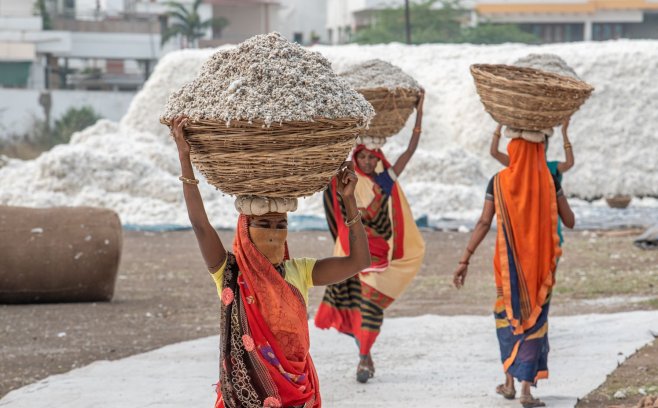
Owens Corning recognised by CDP
Opinion


Initiative calls on industry players to take urgent, interlinked action.

23rd June 2021
Adrian Wilson
|
London
The first-ever global analysis of climate risks to global cotton production reveals that runaway climate change could expose half of all global cotton growing regions to high risks from temperature increases, changes to rainfall patterns and extreme weather events by 2040.
Adapting to climate change – physical risk assessment for global cotton production was commissioned by the Cotton 2040 initiative, which is facilitated by London-based sustainability non-profit Forum for the Future and supported by the Laudes Foundation. The analysis was conducted by Cotton 2040 partner and climate-risk specialists Acclimatise, part of Willis Tower Watson.
The widespread shifts to sustainable forms of cotton production must be bolstered by ambitious and aligned action to reduce carbon emissions while also preparing the industry to operate in a very different world
Under a worst-case climate scenario, it stresses that all global cotton growing regions will be exposed to increased risk from at least one climate hazard by 2040. While these increases range from very low to very high risk, half of the world’s cotton growing regions will face drastic changes with high or very high-risk exposure to at least one climate hazard. Other key findings include:
-All six highest cotton-producing countries – India, the USA, China, Brazil, Pakistan and Turkey – are exposed to increased climate risk, particularly from wildfire, drought and extreme rainfall.
-The highest climate risk overall is projected for two regions – north western Africa, including northern Sudan and Egypt, and western and southern Asia.
-Some regions are set to face high or very high exposure to up to seven climate hazards.
-Cotton exposure to heat stress (defined as temperatures above 40°C) will be an increased risk across 75% of cotton growing regions, with the risk being high or very high across above 5% of regions.
-40% of global cotton growing regions are projected to experience a decrease in growing season as temperatures increase beyond the optimum temperature range for cotton growing.-
-Water scarcity and extremes in rainfall – from insufficient in some regions to extreme and more intense in others – will present increased risks for the world’s most productive cotton growing regions. This will add extra pressure to a fibre already under scrutiny for its water footprint, affecting yields and potentially threatening to cause conflict and societal unrest.
-Exposure to increased risk from drought will impact around 50% of cotton.
-20% of the world’s cotton growing regions will be exposed to increased risk from fluvial flooding by 2040, and 30% of cotton growing regions will be exposed to increased risk from landslides.
-All cotton growing regions will be exposed to increased risk from wildfires.
-60% of cotton will be exposed to increased risk from damaging wind speeds, and up to 10% will be exposed to increased risk from storms.
Wake-up call
“This analysis is a wake-up call for the cotton industry, on which much of the apparel sector is currently hugely reliant,” said Sally Uren, chief executive at Forum for the Future. “In order to build resilience for a highly disrupted and uncertain future, the widespread shifts to sustainable forms of cotton production must be bolstered by ambitious and aligned action to reduce carbon emissions while also preparing the industry to operate in a very different world.”
“As it stands, emission reduction commitments and targets are being missed by the majority of countries, meaning that warming of more than 3°C is probable by the end of this century,” added Willis Tower Watson director Alastair Baglee. “However successful we are with decarbonisation, we will face decades of unavoidable climate change and disruption. Preparing today is essential if we are to limit the impacts of climate change on society.”
Cotton has a market value of about $12 billion, makes up about 31% of all raw material used in the global textile market with a yearly economic impact of over $600 billion and supports the livelihoods of around 350 million people who cultivate or process it. Approximately 90% of farmers grow cotton on less than two hectares of land and are located in developing countries, mainly in Central and West Asia, Southeast Asia, and Africa.
The global analysis is complemented by an in-depth analysis of physical climate risks and socio-economic vulnerabilities to the cotton value chain in India. This highlights that climate impacts extend beyond direct impacts to cotton production, affecting the entire value chain, including workers involved in harvesting and processing, as well as supply chains.

Business intelligence for the fibre, textiles and apparel industries: technologies, innovations, markets, investments, trade policy, sourcing, strategy...
Find out more